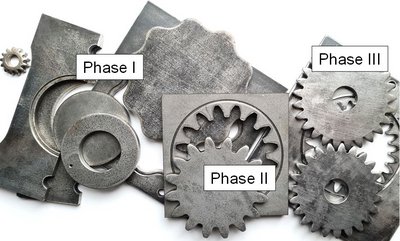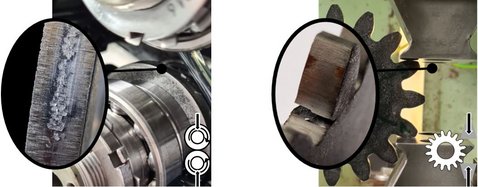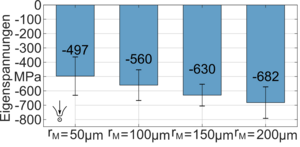Characterization and Utilization of Process-Induced Residual Stresses for the Manufacturing of Functional Surfaces by Near-Net-Shape-Blanking Processes
Research Topic
| Short Title | Fineblanked Gear III |
| Start of Project | Q4/2022 |
| Funding | DFG-Nr. 374524261, SPP 2013, STA 1198/13-3 Deutsche Forschungsgemeinschaft, DFG |
| Website | |
| Project Partner | Chair of Metal Forming and Casting, utg, TU Munich |
| Contact | Dr.-Ing. T. Tobie |
Project Description
Near-Net-Shape Blanking processes are shear cutting processes that are able to manufacture parts with functional surfaces that need no or only minimal post-processing. The functional surfaces are produced by plastic deformation, which can be used to control the residual stress state of the final component and thus its fatigue strength. The use of base materials with higher strength in combination with process-induced compressive residual stresses has considerable potential in terms of increasing the load-bearing capacity with regard to fatigue caused by pitting and tooth root fracture. This offers the potential to replace cost- and time-intensive heat treatment in the manufacturing of power-transmitting gears by increasing the fatigue strength by locally adapted residual stresses.
In the two-year follow-up project, this potential is to be investigated on a shear-cut pinion/wheel pairing made from the previously used reference material and a high strength steel. Basic relationships will be determined on the basis of the tooth root fatigue strength in pulsator tests and the pitting load capacity in running tests.
The residual stress states of the different gear variants are measured both before and after the fatigue tests. This allows to track process improvements but also ensures the predictability of the property improvements. Thus, these measurements are used to extend the existing residual stress simulation model.
By using a high strength steel material, it will be shown that further improvements can be achieved in terms of tooth root fatigue strength and pitting through process-induced residual stresses. Both experimental and numerical investigations are carried out for this purpose. In addition, the prediction of the pitting and tooth root fatigue strength for the reference material and the higher strength material will be evaluated and improved if necessary. A simplified model for the calculation of the pitting load carrying capacity is being developed for both materials. By integrating the results into the bidirectional model from the second funding period, it will thus be possible to design and manufacture gears of different materials and geometries with increased tooth root fatigue strength and pitting load bearing capacity by utilizing the positive effect of shear cutting process-induced residual stresses.
Thus, the focus of the project is the design, layout and optimization of the NNSB processes with regard to an improved residual stress state for higher tooth root and pitting load-bearing capacity, ensuring the predictability of the property improvements caused by residual stresses, and demonstrating residual stress stability in running tests under real operating conditions.
Literature
Residual stresses in parts manufactured by near-net-shape-blanking. J. Stahl, D. Müller, R. Golle, T. Tobie, W. Volk and K. Stahl. Residual Stresses in Production Technology, Production Engineering, Springer, Volume 3, No.2, 2019
The Influence of Residual Stresses Induced by Near-Net-Shape Blanking Processes on the Fatigue Behavior under Bending Loads. J. Stahl, D. Müller, I. Pätzold, R. Golle, T. Tobie, W. Volk and K. Stahl. IOP Conference Series: Materials Science and Engineering, Volume 651, 38th International Deep Drawing Research Group Annual Conference, Netherlands, 2019
Calculation of sub-surface-initiated fatigue fractures in gears. D. Müller, T. Tobie and K. Stahl. XIV International Conference on Computational Plasticity. Fundamentals and Applications (COMPLAS2019), Spain, 2019
Influence of Shear Cutting Process Parameters on the Residual Stress State and the Fatigue Strength of Gears. D. Müller, J. Stahl, I. Pätzold, R. Golle, T. Tobie, W. Volk and K. Stahl. The 13th International Conference on the Technology of Plasticity, USA, 2021
Shear Cutting Induced Residual Stresses in Involute Gears and Resulting Tooth Root Bending Strength of a Fineblanked Gear. D. Müller, J. Stahl, A. Nürnberger, R. Golle, T. Tobie, W. Volk and K. Stahl. Archive of Applied Mechanics, 2021
On the Formation of Residual Stresses in Blanks Manufactured by Near-Net-Shape-Blanking Processes. J. Stahl, D. Müller, A. Nürnberger, T. Gress, P. Lechner, R. Golle, T. Tobie, W. Volk and K. Stahl. The International Journal of Advanced Manufacturing Technology, 2021
Einfluss von prozessinduzierten Eigenspannungen auf die Zahnfußtragfähigkeit schergeschnittener Zahnräder. D. Müller, J. Stahl, A. Nürnberger, R. Golle, T. Tobie, W. Volk and K. Stahl. Forschung im Ingenieurwesen, 2021
The frictional force between slug and die in shear cutting after material separation. J. Stahl, D. Müller, I. van den Bosch, L. Kindsmüller, R. Golle, T. Tobie, W. Volk and K. Stahl. Key Engineering Materials, 2021
Residual stresses induced by shear cutting - Targeted use for manufacturing functional surfaces with an improved fatigue behavior. J. Stahl, Dissertation, TUM, 2021
Comparative study of v‑ring indenter configurations in fineblanking in order to derive tool design guidelines. A. Nürnberger, D. Müller, L. Martinitz, C. Hartmann, T. Tobie, K. Stahl and W. Volk; International Journal of Advanced Manufacturing Technology) 123 (2022) (doi.org/10.1007/s00170-022-10345-6)


